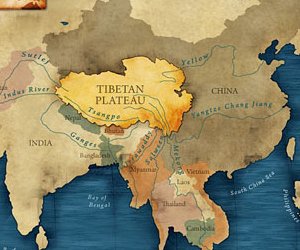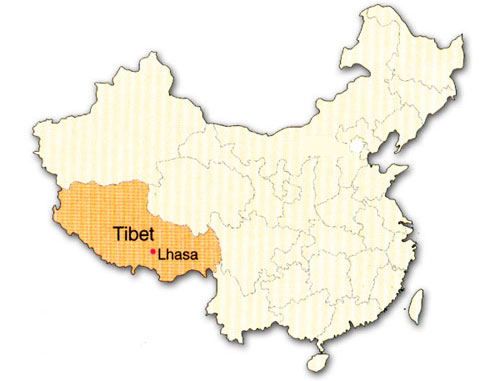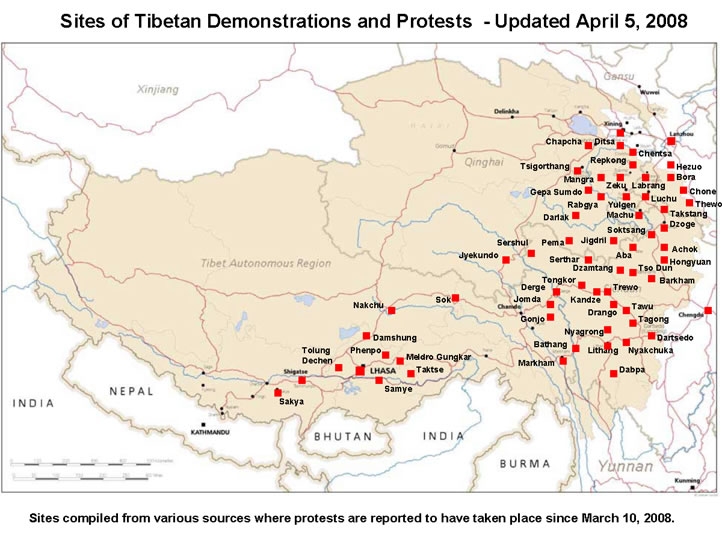When Tibetans refer to ‘Tibet’ they are talking about the entity comprising the three provinces of U-Tsang, Kham and Amdo. The two Tibetan provinces of Kham and Amdo are now largely incorporated into the Chinese provinces of Qinghai and Sichuan (upper/right regions in brown on the map). Tibet’s traditional territory now accounts for one quarter of the landmass of the People’s Republic of China.
When the Chinese talk about ‘Tibet’, they are referring only to the Tibet Autonomous Region (TAR), an administrative region created by the Chinese occupiers in 1965. The TAR (lower/left regions) includes less than half the total Tibetan lands and contains only a third of the total Tibetan population.


Tibetan Version and Chinese Version.
Below shows recent uprising that spread all over Tibet. Chinese efforts to divide Tibet has failed!

Facts About Tibet: Land Size: Total 2.5 million square kilometres (or 965,000 square miles). The TAR, consisting of U-Tsang and a small portion of Kham, is 1.2 million square kilometres in size. More than half the landmass of Tibet lies outside of the TAR.
Population: There are around 6 million Tibetans; 2.7 million live in the TAR and the remainder in the Tibetan areas outside the TAR. There is also an undetermined number of Chinese in the Tibetan areas with the Tibetan Government-in-Exile estimating that the Chinese now outnumber Tibetans in Tibet. Additionally, approximately 120,000 Tibetans live in exile.
Legal Status: Occupied by China.
Government: The Communist Party of China rules occupied Tibet. However Tibetans, both inside Tibet and in exile, recognise the Tibetan Government in Exile based in Dharamsala, India as their legitimate government.
Head of State: His Holiness the 14th Dalai Lama. Now living in exile in Dharamsala, India. The Head of State under Chinese occupation is the Chinese President Hu Jintao.
Administration: Under Chinese rule, the Tibetan landmass has been divided into the following administrative units: a) Tibet Autonomous Region, b) Haibei [Tibetan: Tsochang] Tibetan Autonomous Prefecture, Hainan [Tsolho] Tibetan Autonomous Prefecture, Huangan [Malho] Tibetan Autonomous Prefecture, Guoluo [Golog] Tibetan Autonomous Prefecture, Yushu [Jyekundo] Tibetan Autonomous Prefecture and Hiaxi [Tsonub] Mongolian-Tibetan Autonomous Prefecture in Qinghai Province, c) Tianzu [Pari] Tibetan Autonomous County and Gannan [Gannan] Tibetan Autonomous Prefecture in Gansu Province, d) Aba [Ngaba] Tibetan-Qiang Autonomous Prefecture, Ganzi [Kardze] Tibetan Autonomous Prefecture and Mili [Mili] Tibetan Autonomous County in Sichuan Province, e) Diqing [Dechen] Tibetan Autonomous Prefecture in Yunnan Province.
Language: Tibetan. The official language in Tibet following the occupation is Chinese.
Religion: The majority of Tibetans practice Tibetan Buddhism. Other religions: Bon, Islam, Christianity.
Economy: Tibetans ate predominantly in the agriculture and animal husbandry. Chinese are predominantly in government, commerce and the service sector.
Major Rivers: Yarlung Tsangpo (Brahmaputra in India), Machu (Yellow River in China), Drichu (Yangtse in China), Senge Khabab (Indus in India), Phungchu (Arun in India), Gyalmo Ngulchu (Salween in Burma) and Zachu (Mekong in Thailand, Vietnam, Cambodia, Laos).
Bordering Countries: India, Nepal, Bhutan, Burma, East Turkestan (north of Tibet, not shown; also occupied by China), China
Average Altitude: 4,000 metres or 13,000 feet above sea level
src = http://www.tibetnetwork.org
